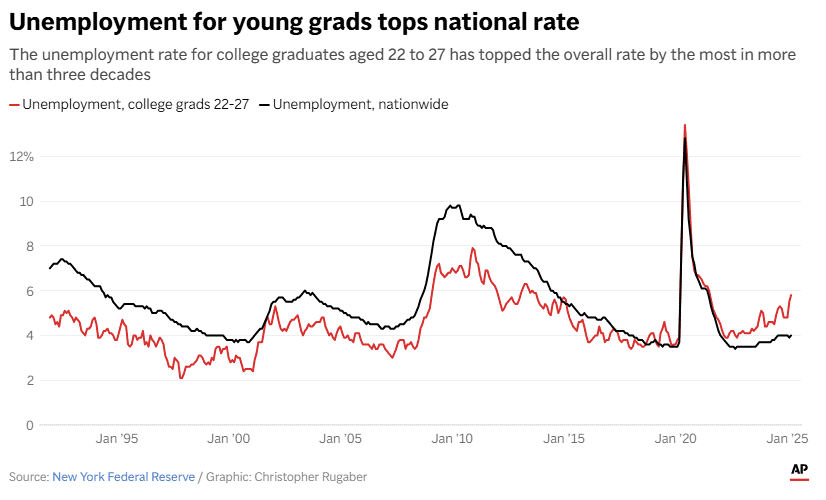A degree in uncertainty: why college grads are struggling to find work
The Sandbox Daily (8.28.2025)
Welcome, Sandbox friends.
Today’s Daily discusses:
the vanishing college premium
Let’s dig in.
Blake
Markets in review
EQUITIES: Nasdaq 100 +0.58% | S&P 500 +0.32% | Russell 2000 +0.19% | Dow +0.16%
FIXED INCOME: Barclays Agg Bond +0.12% | High Yield +0.05% | 2yr UST 3.631% | 10yr UST 4.205%
COMMODITIES: Brent Crude +0.41% to $68.33/barrel. Gold +0.82% to $3,476.8/oz.
BITCOIN: -0.12% to $111,989
US DOLLAR INDEX: -0.34% to 97.898
CBOE TOTAL PUT/CALL RATIO: 0.75
VIX: -2.83% to 14.43
Quote of the day
“As our island of knowledge grows, so does the shore of our ignorance.”
- J.A. Wheeler
The vanishing college premium
Many of us were indoctrinated with the idea that if you wanted a good job, you went to college.
Why? Unemployment rates for college grads have been consistently below those who had lower levels of educational attainment, not to mention the sizable gap in wages earned.
Well, that seems to be changing.
The unemployment rate for college graduates has been steadily rising since the post-pandemic trough. See the top pane in the graphic below.
Even worse, recent data shows that unemployment among young college graduates (ages 22–27) has climbed to 5.8%, the highest in well over a decade outside the pandemic and a stark contrast to the 3.25% rate this same demographic experienced in 2019.
Remarkably, their jobless rate (red line below) now outpaces the national average (black line), something we don’t see in a non-recessionary economy.
The stories behind the numbers are sobering. Anecdotes abound of résumés stacked with internships, advanced degrees, and spotless GPAs – still going unanswered.
Even computer science majors, once guaranteed safe harbor, are struggling: employment among younger comp-sci grads is down 8% since 2022, while older peers have eked out gains.
AI makes for splashy headlines, but evidence suggests it isn’t the main culprit, at least not yet. Adoption remains patchy, and majors like math, accounting, and business analytics – all AI targets – are doing better today than before the pandemic.
This large of a labor shift represents more than just statistical noise; it reflects a significant change in how the economy is absorbing newly educated workers.
Murat Tasci, an economist at JPMorgan, calculates 45% of U.S. workers now have a four-year degree, up from 26% in 1992. So, oversupply is one firm explanation beyond just AI.
Another is the economic backdrop. Employers facing tariffs, erratic immigration policies, and slower growth are reluctant to commit to entry-level hires who need training.
Longer-term, a structural shift matters.
Research shows graduating into a weak labor market can leave scars for decades: lower earnings, worse health, even weaker family formation. Layer on student debt and the weight gets heavier.
For investors, the implications ripple outward.
A generation slowed in the transition from school to work means delayed home-buying, softer consumption, and a more cautious middle class. Bond investors may welcome the disinflationary pressure, but the long-term drag on growth is real.
The college diploma hasn’t lost all its value. Lifetime earnings still skew higher.
But the premium is shrinking, and the old promise that higher education guarantees a better start looks to be on shakier ground.
Sources: Federal Reserve Bank of New York, Associated Press, Yahoo Finance, Ned Davis Research
That’s all for today.
Blake
Questions about your financial goals or future?
Connect with a Sandbox financial advisor – our team is here to support you every step of the way!
Welcome to The Sandbox Daily, a daily curation of relevant research at the intersection of markets, economics, and lifestyle. We are committed to delivering high-quality and timely content to help investors make sense of capital markets.
Blake Millard is the Director of Investments at Sandbox Financial Partners, a Registered Investment Advisor. All opinions expressed here are solely his opinion and do not express or reflect the opinion of Sandbox Financial Partners. This Substack channel is for informational purposes only and should not be construed as investment advice. The information and opinions provided within should not be taken as specific advice on the merits of any investment decision by the reader. Investors should conduct their own due diligence regarding the prospects of any security discussed herein based on such investors’ own review of publicly available information. Clients of Sandbox Financial Partners may maintain positions in the markets, indexes, corporations, and/or securities discussed within The Sandbox Daily. Any projections, market outlooks, or estimates stated here are forward looking statements and are inherently unreliable; they are based upon certain assumptions and should not be construed to be indicative of the actual events that will occur.
Please see additional disclosures (click here)
Please see our SEC Registered firm brochure (click here)
Please see our SEC Registered Form CRS (click here)






